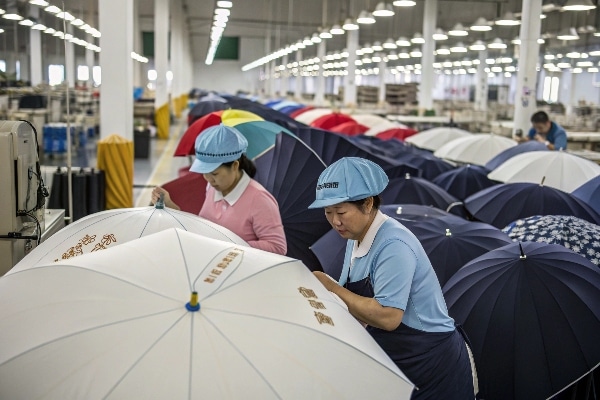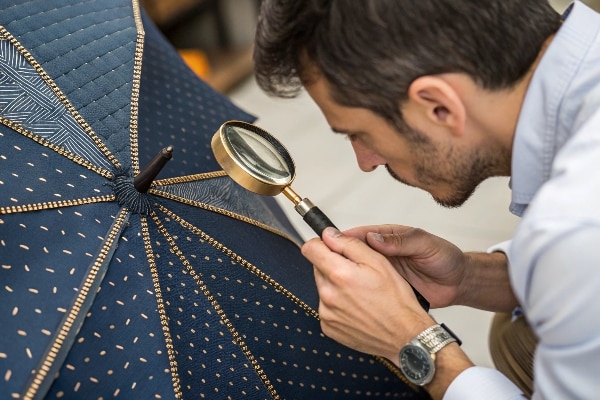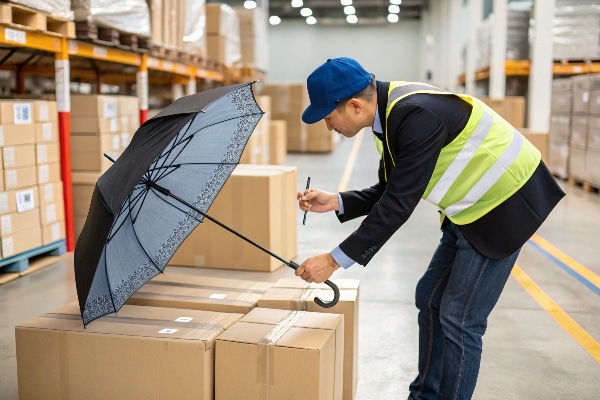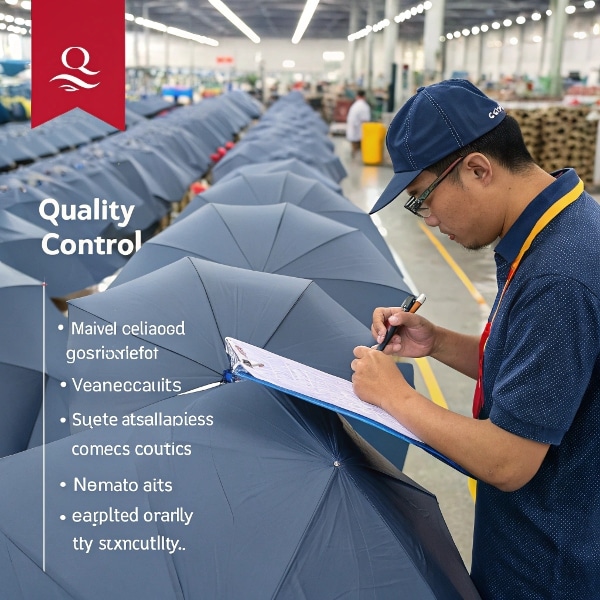Table of Contents
How to Ensure Umbrella Quality When Sourcing from China

When sourcing umbrellas from China, the process can feel overwhelming. It’s crucial to avoid quality issues that could end up costing you. I’ve been there before and learned through trial and error. But with the right approach, you can get high-quality products delivered on time.
Ensuring umbrella quality is all about having the right systems in place. If you stay organized and focused, you’ll avoid the costly pitfalls that many companies face when sourcing from China.
Let’s dive into the key steps that guarantee your umbrellas meet the quality standards you’re aiming for.
What Are the Key Steps in Quality Control for Umbrellas?

I can’t emphasize enough how important it is to have a step-by-step inspection process when sourcing umbrellas. Here’s how I make sure the umbrellas I source meet the quality standards every time.
The first thing I always do is inspect the style and design of the umbrella. That includes checking the materials, dimensions, stitching, and labeling, among other things. Each detail is important in making sure the product is exactly what we want.
Style and Design Inspection
The design of the umbrella must be checked carefully. Compare the umbrella with reference samples or your specifications. This includes checking things like stitching, seam construction, and the density of stitches. Also, verify that all accessories like buttons, snaps, and Velcro tapes meet the correct style, size, color, and position.
Material and Touch Feel
Next, I check the material by touch. The feel of the fabric is critical to ensure the umbrella feels premium. Compare the fabric with a sample to ensure consistency. The color also plays a big role. Ensure that the color of the fabric, accessories, and prints is in line with the reference sample.
Size and Labeling
Size inspection is another area to focus on. Measure the umbrella’s diameter, length, and ribs against the specifications. Usually, I inspect about 10% of the products to make sure they meet the exact dimensions. Then, I look over all the labels carefully. Ensure the brand name, care instructions, and other relevant information are correctly printed.
Packing Inspection
Packing is just as important as the product itself. Inspect the packaging material to ensure it’s durable enough for shipping. Check that the quantity and assortment of the umbrellas match the packing list and carton markings.
Special Tests and Performance Checks
Before the umbrella goes into full production, I also conduct special tests. These can include checking humidity for wooden parts or performing wind and rain resistance tests. These tests ensure the umbrella functions as intended under various weather conditions.
By following these steps, I’ve been able to avoid quality issues and ensure the umbrellas I source are up to the highest standards.
How Can You Avoid Quality Issues When Sourcing from China?

Having sourced many products from China, I’ve learned that preventing quality issues starts with the right approach. It’s about taking control and being proactive in your communication and inspection methods.
Avoiding quality problems is all about clear communication and systematic checks. The more thorough you are upfront, the less likely you are to encounter major issues later.
Define Clear Product Specifications
The first step in avoiding problems is making sure your product specifications are clear. Be specific about materials, sizes, and packaging. Make sure everything is written down in detail and shared with your supplier. If you need, have these specifications translated into Mandarin to avoid misunderstandings.
Select a Reliable Supplier
Don’t just choose any supplier. Take the time to research and pick one with a proven track record. Check reviews, request references, and look for suppliers who specialize in umbrellas. Directories like Alibaba can be a good starting point, but I’ve found it’s best to dig a little deeper.
Request Pre-Production Samples
Always get a sample before the full production run. This will give you an idea of the quality you can expect and allow you to catch any issues before it’s too late.
Conduct Factory Audits
When you’re selecting a supplier, be sure to conduct a factory audit. This helps you assess the supplier’s quality control process, manufacturing capabilities, and compliance with industry standards. You can either do this yourself or hire a third-party company to conduct the audit.
Develop a Comprehensive Quality Control Plan
Creating a quality control plan is essential. This plan should outline your product standards, testing procedures, and quality checkpoints. It’s a good idea to use AQL (Acceptable Quality Level) standards for larger orders to maintain consistency.
Implement Regular Inspections
Don’t wait until the end to check the product. Regular inspections at different stages of production (pre-production, in-process, and pre-shipment) help you catch problems early. I personally hire third-party inspection companies to ensure an unbiased evaluation.
By taking these proactive steps, you can significantly reduce the risk of quality issues and ensure that the umbrellas you source meet your expectations.
What Are the Best Practices for Umbrella Inspection?

Over time, I’ve learned the best practices for inspecting umbrellas. These inspections go beyond just looking at the finished product—they ensure that every detail is just right.
The best practices for inspecting umbrellas cover everything from size verification to performance testing. By following these steps, I can ensure the final product is both high quality and functional.
Size and Dimension Verification
Size is critical when it comes to umbrellas. Measure the umbrella’s diameter, length, and rib length to ensure they align with your specifications. Generally, I inspect about 10% of products to make sure they fall within acceptable tolerance ranges.
Performance Testing
It’s not just about how the umbrella looks—it’s about how it functions. I test the opening and closing mechanism by performing multiple cycles on a sample of umbrellas to ensure smooth operation. The umbrella should open and close without any issues.
Material and Color Verification
Materials and colors should be consistent with the reference samples. I pay close attention to color batches and make sure all parts of the umbrella, including fabric and accessories, match the agreed-upon colors. Any discrepancies here could lead to dissatisfaction from customers.
Stitching and Seam Inspection
Stitching is a key part of umbrella durability. I always check the seams for strength and integrity. If there are any loose threads or weak stitching, it can lead to the umbrella falling apart under stress, so it’s something I never overlook.
Packaging and Labeling Verification
The packaging should be sturdy enough to protect the umbrellas during transit. I also verify the labels to ensure they are correct, with the right font, style, and text. It’s also important to check that the packaging complies with all shipping and regulatory requirements.
By incorporating these best practices into your inspection routine, you can be confident that the umbrellas you source will meet quality and safety standards, reducing defects and improving customer satisfaction.
How Can You Ensure Consistent Umbrella Quality?

Ensuring consistency in umbrella quality is one of the most important factors in maintaining a strong brand. I’ve learned that implementing thorough checks at every stage of production is the key to keeping quality consistent.
To ensure consistent quality, I make sure that I’m checking every part of the process—from incoming materials to pre-shipment inspections. This helps me maintain a high level of quality for every order.
Incoming Quality Control Inspection
Quality starts with raw materials. I inspect all the incoming materials, such as fabric, ribs, and handles, to ensure they meet the required specifications. If the materials don’t meet the standard, it’s better to catch it early than during production.
Pre-Production Inspection
Before starting mass production, I always inspect pre-production samples. This step helps to confirm that the umbrella is being made to the right specifications. If the samples don’t meet the mark, I make adjustments before moving forward.
In-Process Quality Control Inspection
During production, I monitor the process closely. This includes inspecting fabric cutting, sewing, and assembling parts. I conduct regular checks throughout production to ensure that everything is on track.
Final Quality Control and Pre-Shipment Inspection
Before the umbrellas leave the factory, I perform one last inspection to make sure they meet the required quality standards. This final check looks at everything from size to function to overall appearance.
Continuous Improvement
One of the best things you can do is regularly review your quality control processes. By analyzing the results and collecting feedback, I can identify areas for improvement and make adjustments to maintain consistency.
By following these steps, I ensure that every umbrella I source meets the highest quality standards, helping to maintain a consistent product offering for my customers.
Why Is Supplier Communication Crucial for Quality Control?

Supplier communication is something I’ve learned not to underestimate. A small miscommunication can lead to major problems down the line. I make sure to communicate clearly and frequently with my suppliers to keep everything on track.
Clear communication with suppliers is essential to maintain quality control. It helps prevent misunderstandings, ensures the supplier knows what’s expected, and allows for quick action if there are any issues.
Clear Expectations
Setting clear expectations from the start is the best way to avoid problems. I always make sure that I clearly communicate the specifications, quality standards, and expectations. This ensures that both sides are on the same page and reduces the likelihood of errors.
Early Issue Detection
Good communication allows us to detect any issues early on. Whether it’s a problem with materials or production delays, staying in touch with the supplier means that we can address any issues quickly before they snowball into bigger problems.
Collaborative Problem-Solving
When issues arise, it’s crucial to work together to find solutions. I communicate openly with my suppliers to resolve any challenges. A collaborative approach helps keep things running smoothly and improves the overall quality of the product.
Performance Monitoring and Feedback
I regularly monitor supplier performance and provide feedback. Communication is key here, as it ensures that the supplier understands how they’re performing and where they need to improve. I also ask for regular updates on production status to stay in the loop.
Building Trust and Relationships
Strong communication builds trust. By staying in touch and maintaining open lines of communication, we can build a long-term, productive relationship with the supplier. This leads to more reliable deliveries, fewer mistakes, and higher-quality products.
By maintaining open and clear communication, I ensure that the quality of the umbrellas I source meets the highest standards.
Conclusion
Quality control is a vital part of sourcing umbrellas from China. By defining clear expectations, inspecting every part of the process, and maintaining good communication, you can ensure that your umbrellas meet the desired quality and perform as expected.

